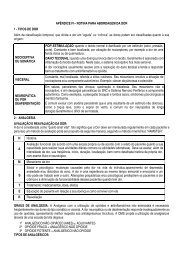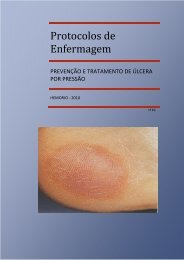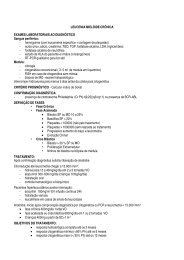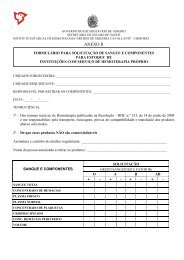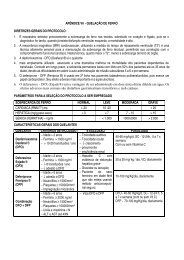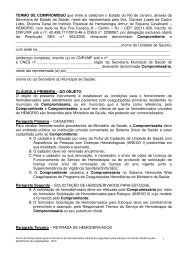Protocols - Hemorio
Protocols - Hemorio
Protocols - Hemorio
Create successful ePaper yourself
Turn your PDF publications into a flip-book with our unique Google optimized e-Paper software.
HEMATURIA:<br />
- DO NOT start replacement therapy, at first.<br />
- General care: bed rest, vigorous hydration (oral). Avoid urinary infection<br />
- If in 72 hours macroscopic hematuria does not give in, increase FVIII or FIX according to Table 3, until<br />
macroscopic hematuria disappears.<br />
- After hematuria is resolved, investigate etiology (ultrasound of urinary ways, EAS, excretion urography).<br />
- In refractory cases - Prednisone 1 to 2mg/kg weigh / day for 2 days.<br />
- NEVER administer Antifibrinolytics.<br />
GI HEMORRHAGE:<br />
- Replacement of deficient factor (Table 3)<br />
- Antifibrinolytics<br />
- General clinical care: diet, antacid, ranitidine or omeprazol.<br />
- Hemostatic packed may be considered as a therapeutic option.<br />
Note: Use in HDA cases, before and after cauterization: hemostatic packed: gelfoan 10 cm + adrenaline 1<br />
ampoule + EACA 1-4g + SF0, 9%%, 250ml water or cold milk. Mix and drink 100ml 1/1h PO.<br />
CRANIAL TRAUMA:<br />
- MINOR TRAUMA: increase FVIII or FIX to 50%, every 24 hours, during 3 days;<br />
- MAJOR TRAUMA: increase F VIII or IX according to table 3.<br />
It is necessary to confirm the diagnosis of intracranial hemorrhage with:<br />
1- Neurological evaluation<br />
2- Fundus of eye evaluation<br />
3- Cranial x-ray – fracture evaluation<br />
4- Cranial CT always; in case there is no bleeding image, repeat it in 15 days for control.<br />
- LIQUOR PUNCTURE REQUIRED: perform replacement of FVIII or IX according to Table 2.<br />
63



